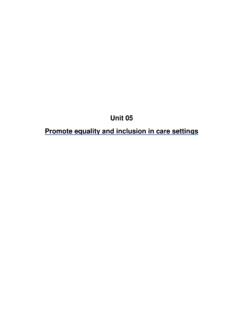Transcription of Group C Understanding Assessment in Education and …
1 Group C. Understanding Assessment in Education and training Zena Betts Explain the purposes of types of Assessment used in Education and training According to Petty (2014): Assessment measures the breadth and depth of learning'. An initial or diagnostic Assessment establishes the starting point and ascertains the student's previous skills and knowledge. This enables the student to see how much he/she achieves during the course, it also fosters a more reflective approach to learning and enables the teacher to effectively plan the individual student's needs.
2 The teacher can then review the students' progress and achievements, which improves the quality of teaching A formative Assessment provides informal feedback and information during the teaching process. This Assessment measures student progress and performance thus allowing further improvement and development. It can also assess the teacher's progress as an instructor, enabling the teacher to evaluate the effectiveness of their teaching methods[DH1]. The summative Assessment is a formal Assessment that takes place at the end of the learning course, module or programme.
3 It used to measure the achievement of set criteria quality of the work produced. This type of Assessment is often stressful to students and can result is failure, even though the student is more than capable of achieving the required result under other conditions[DH2]. There is usually a grade awarded with this Assessment , along with a certificate of achievement. Describe characteristics of different methods of Assessment in Education and training The Assessment methods are varied and could include any or all of the following: Discussion this enables students to talk about the chosen subject, share knowledge and ideas, before arriving at a conclusion.
4 Observations this involves watching the student while they complete a task or exercise. Multiple choice questions here you are asking the student to choose the correct answer from several alternatives. Case studies this could be a description of an actual event, students are asked to analyse the situation and give suggestions. Gapped hand-outs or workbooks this is a way of checking knowledge sentences have missing words which students must complete. Scenarios this method enables students to think about situations that may occur in a real time environment, anticipate the context in which they have to act and the consequences of their decisions.
5 1. Group C. Understanding Assessment in Education and training Zena Betts Compare the strengths and limitations of different Assessment methods in relation to meeting individual learner needs Assessment method Strengths Limitations Meeting Individual needs Discussion Everyone can participate, Digression from main Students with visual no formal feedback, subject, domination from impairments can join in students can describe some students, time and may prefer an previous experiences consuming, there could informal setting rather and knowledge be arguments, and than completing a written passive students may not task.
6 Be assessed. Observations Skills can be seen in Time consuming, forward Students that preferring action, students can planning required kinaesthetic learning may perform the task several space limitations, no find this an easier and time if a mistake is made permanent record stress free form of instruction. Multiple choice Can be short or long, can Closed questions don't Students that don't like questions challenge a student's demonstrate knowledge writing large amounts potential, question bank or Understanding . could benefit, questions can be devised which Students could share could be read out and can be used multiple answers answered orally.
7 Times. Case studies / Can be a description of Must have a clear Actual events can help scenarios an actual event, can be conclusion, may be time motivation and enhance an individual or Group consuming to prepare the knowledge of the event and assess. Time student. Conclusion can consuming to prepare. be in the form of a discussion or written up. Gapped hand outs / Could be used as an Mature students might Good for students at a workbooks informal Assessment find the concept lower level, work books activity as an individual, derogatory, workbooks could be produced for pairs or small groups.
8 Must have an interesting varying degrees of variety of information or difficulty. Students can students may become work at their own bored. pace[DH3]. Explain how different Assessment methods can be adapted to meet individual learner needs Students learn and process knowledge at different levels. When teaching the staff at work I. am aware that they are from all walks of life and some will require varying degrees of assistance. When delivering the training I have set objectives that must be met. I go through these with the staff at both the beginning and end of the course to ensure that everything has been covered, staff have understood and that the learning objectives have been achieved.
9 I ensure that I use SMART objectives (specific, measurable, achievable, relevant, time bound) and that the Assessment should be valid, reliable, transparent, fair, equitable, formative, timely and authentic. When staff complete assignments I know that some will find these easy and others will struggle. Multiple choice questions may suit a student with a visual impairment or Dyslexia, 2. Group C. Understanding Assessment in Education and training Zena Betts as coloured paper could be used, a larger font, the questions could be given verbally or be printed in another language.
10 When completing a Moving and Handling course (as required under the health and safety at work act 1974) I use several methods, Group discussion, visual DVD presentation, written questionnaire and a practical demonstration, using all four methods ensures that maximum learning objectives are achieved. There are times when a written examination is required, I use this form of Assessment when the student Group are of a higher educational level (this having been assessed at the initial stage under functional skills requirements), respond well under examination conditions and like the challenge of a formal exam[DH4].











